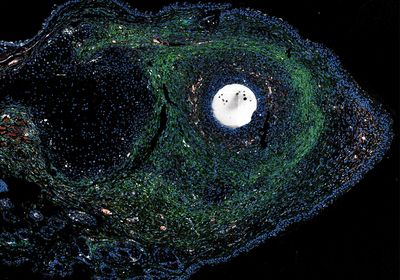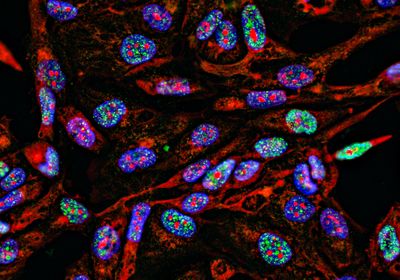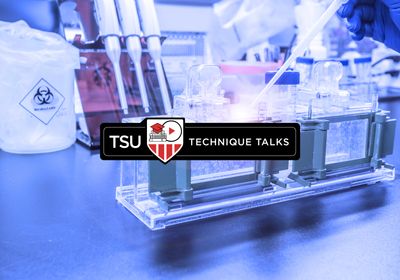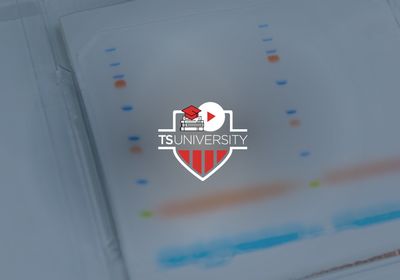ABOVE: The researchers at the University of Kentucky and the Hubrecht Institute embedded beads soaked in ERK-activation growth factor mix (shown in white in this fluorescence microscopy image of a mouse ear) into the ears of common mice, and the tissue regenerated in response (shown in green). Antonio Tomasso
The seemingly magical regrowth of salamander tails and starfish arms after injury has always captured the attention of scientists. In recent years, they have also been excited about the spiny mouse, a small rodent discovered in 2012 to shed and regrow its skin1 because the existence of a regenerating mammal hints at the possibility of scarless healing in mammals more broadly.
Now, researchers at the University of Kentucky and the Hubrecht Institute have shown that boosting the activation of extracellular signal-regulated kinase (ERK), a common signaling molecule, can help common mice heal themselves in the same way as spiny mice do,2 suggesting that the ability to regenerate could lie dormant in other mammals, including humans.
The regenerative capacity in mammals is still there.
—Monica Sousa, University of Porto
The team suspected that ERK was important for the spiny mouse’s self-healing because ERK plays an important role in tissue healing. They began by exploring whether injury-related activation of ERK naturally differed between spiny mice and common mice. To do this, they punched holes in the ears of both types of mice and measured the levels of phosphorylated (activated) ERK over the following days and weeks, as the common mouse ears became edged in scar tissue and the spiny mouse ears seamlessly closed.
“What we discovered was that ERK is equally activated at the onset of injury in both species, although activated to a higher degree [in spiny mice],” said biologist Ashley Seifert from the University of Kentucky, who led the work and first discovered the spiny mouse’s special abilities. That high ERK activation persisted in the spiny mouse ear for several weeks, whereas ERK activation in common mice dropped significantly after day 10.
To test if this prolonged high ERK activity was necessary for the spiny mouse’s scarless healing, the team used a chemical to inhibit the activating ERK phosphorylation. “It completely blocked regeneration,” Seifert said. In fact, when ERK activation was disrupted, the tissue switched to the scar-producing phenotype seen in the common mice.
Remarkably, it worked the other way, too. When Seifert’s team stimulated ERK activity to a higher level in common mice, either through embedded beads soaked in an ERK-boosting growth factor mix or through viral transduction of an ERK activator, their ear holes started growing back together seamlessly. Holes of two millimeters in radius closed completely, and while the boost was not quite enough to fully close larger holes of four millimeters, the ear tissue was clearly regenerating. “Maybe with a secondary infection, we would have seen more persistent activation,” he said.
Science will discover the ability to stimulate generation of tissues and organs where it does not normally occur.
—Ashley Seifert, University of Kentucky
Mónica Sousa, a neuroscientist at the University of Porto who was not involved with the study, said that the paper suggests that most mammals have the potential for regeneration. “The regenerative capacity in mammals is still there,” she said. “It’s probably dormant and has been evolutionarily pushed back.” She also suspects that there are mammals in the wild today with regenerative abilities that scientists have yet to discover.
Sousa’s own work shows how spiny mice don’t just grow back ear tissue but can regain motor function after suffering a spinal cord injury that would be devastating to other species.4 In that context, ERK has not shown up as a key player, but she plans to explore it. “The way in which it seems to be a master regulator, at least in this type of tissue, is really fascinating,” she said.
The fact that regeneration can be so easily induced in common mice raises the question of why most mammals, including humans, don’t normally have regenerative abilities. “It could be a protective mechanism for mammals to protect the cells from developing into tumors,” said coauthor Antonio Tomasso from the Hubrecht Institute. However, the team saw no indication that the high level of activated ERK led to cancer during the time of the experiment. “You also need other factors that stimulate cells to become cancer cells,” he said.
“Science will discover the ability to stimulate generation of tissues and organs where it does not normally occur,” said Seifert. “I now unabashedly think that [spiny mice] are probably one of our best current models for discovering how to translate some of what we know about regeneration into humans.”
References
- Seifert Aw, et al. Skin shedding and tissue regeneration in African spiny mice (Acomys). Nature. 2012;489(7417):561-565.
- Tomasso A, et al. An ERK-dependent molecular switch antagonizes fibrosis and promotes regeneration in spiny mice (Acomys). Sci Adv. 2023;9(17):eadf2331.
- Owlarn S, et al. Generic wound signals initiate regeneration in missing-tissue contexts. Nat Commun. 2017;8(1):2282.
- Nogueira-Rodrigues J, et al. Rewired glycosylation activity promotes scarless regeneration and functional recovery in spiny mice after complete spinal cord transection. Dev Cell. 2022;57(4):440-450.







